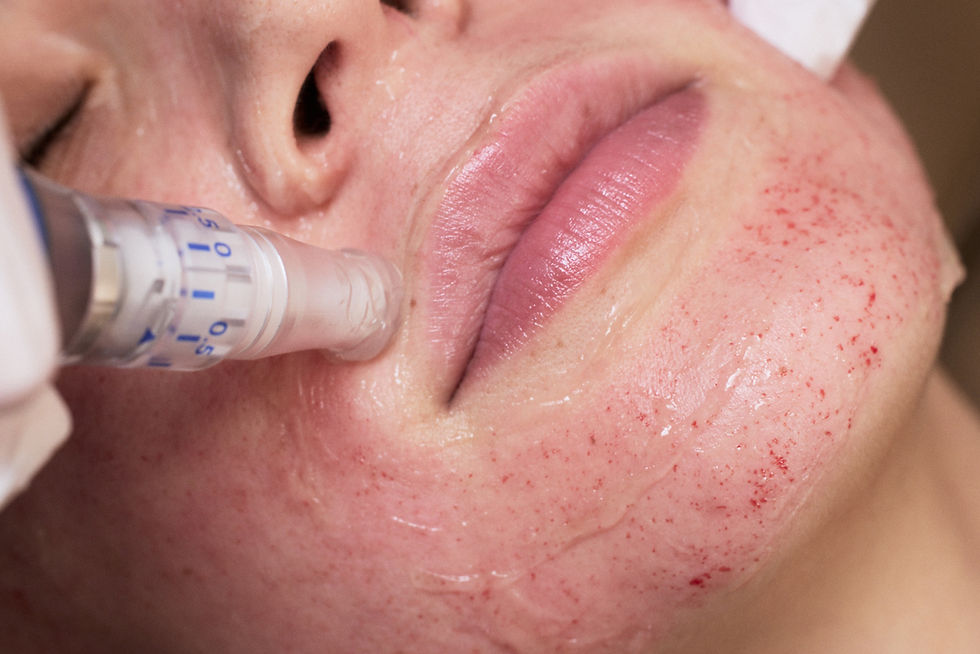What Is Microneedling and How Does It Work?
- Laraib Naeem
- Aug 19
- 4 min read
Microneedling is a popular non-invasive cosmetic procedure designed to rejuvenate the skin by stimulating the body’s natural healing process. Often referred to as collagen induction therapy, this treatment involves the use of tiny, sterile needles that puncture the skin, creating controlled micro-injuries. These micro-injuries trigger the skin’s repair process, resulting in the production of collagen and elastin, which are essential for smooth, youthful-looking skin. Whether you're dealing with fine lines, acne scars, enlarged pores, or uneven texture, microneedling can offer visible improvements. Many people ask, “What is microneedling and how does it work?” This guide covers the treatment process, types, preparation, aftercare, and more to help you make an informed decision.
What is the treatment and how it works?
Microneedling In Dubai(الوخز بالإبر الدقيقة في دبي) is performed using a specialized device that creates thousands of microchannels in the skin. These tiny punctures are not deep enough to cause injury but are sufficient to trigger the body’s healing mechanisms. As the skin heals, it increases the production of collagen, which fills in wrinkles and scars and smooths the skin's surface. The procedure is effective for concerns like hyperpigmentation, stretch marks, dull skin, and even hair thinning in some cases. Depending on the tool used, microneedling can be done with dermarollers, microneedling pens, or advanced devices combined with radiofrequency for deeper penetration and enhanced results. Many users ask, “How long does it take to see results from microneedling?” Visible improvement typically begins after a few weeks as new collagen develops.

Importance and types of microneedling treatment:
The importance of microneedling lies in its ability to naturally enhance the skin without surgery or downtime. It encourages regeneration from within and is suitable for various skin types. Different types of microneedling offer customized benefits depending on the skin concern. Common forms include:
Traditional microneedling: Manual or device-based puncturing of the skin to boost collagen.
Microneedling with PRP: Platelet-rich plasma is added to accelerate healing and enhance results.
Radiofrequency microneedling: Combines heat energy with micro-injuries for deeper skin tightening.
Microneedling with serums: Uses hyaluronic acid or peptides to increase absorption through microchannels.
These variations are chosen based on individual skin needs. A frequently asked question is, “Can microneedling treat both aging and acne scars?” Yes, its versatility makes it ideal for addressing multiple skin concerns in one treatment.
Preparation and aftercare:
Proper preparation enhances the effectiveness and safety of the microneedling procedure. You should avoid sun exposure, exfoliants, and active skincare ingredients like retinol or acids for a few days before the session. The skin should be clean, dry, and free from infections on the day of the treatment.
Post-treatment, aftercare plays a crucial role in achieving optimal results. Here’s what to expect:
Mild redness, similar to sunburn, for 24–48 hours
Avoid makeup for at least 24 hours
Use a gentle cleanser and moisturizer
Apply sunscreen daily and avoid direct sun
Refrain from vigorous exercise for 24 hours
Common user concern: “What should I avoid after microneedling?” The key is to be gentle with your skin—no harsh products, peels, or tanning for at least a week.
Ideal candidate and choosing the right provider:
Microneedling is suitable for most healthy individuals looking to improve their skin’s tone and texture. It is especially beneficial for people with:
Fine lines and early signs of aging
Acne scars and surgical scars
Stretch marks
Uneven skin tone or dullness
Large pores
It is not ideal for individuals with active skin infections, open wounds, or certain skin conditions like eczema or psoriasis. Pregnant or breastfeeding individuals are usually advised to postpone treatment. A common question is, “Who is not a good candidate for microneedling?” Anyone with blood disorders or poor wound healing should consult a professional before proceeding.
When selecting where to have microneedling done, it's important to research thoroughly. Look for an experienced and qualified provider who uses sterile, FDA-approved devices and adheres to strict hygiene protocols. Reviews, photos of past treatments, and experience with your specific skin concern can all influence the outcome. Many ask, “How do I choose the best place for microneedling?” The answer lies in a provider’s skill, safety standards, and transparency.
Risks, benefits, faqs, and conclusion:
Microneedling(الوخز بالإبر الدقيقة) is generally safe when performed correctly, but like any procedure, it carries potential risks. These include:
Temporary redness or swelling
Minor bruising or pinpoint bleeding
Skin flaking or dryness
Hyperpigmentation if post-care is ignored
However, the benefits often outweigh the risks when done properly. Key benefits include:
Improved skin texture and elasticity
Reduction in wrinkles and fine lines
Fading of acne scars and hyperpigmentation
Minimally invasive with low downtime
Natural collagen stimulation
Common FAQs answered:
“How long does microneedling take?” A session usually lasts 30–60 minutes.“When will I see results?” Most people see visible improvement after 2–4 weeks.“Is microneedling painful?” Numbing cream is applied, making it generally comfortable.“Can I do microneedling at home?” At-home devices exist but are less effective and riskier without proper hygiene.“How many sessions do I need?” Typically, 3–6 sessions are recommended for optimal results, spaced 4–6 weeks apart.
In conclusion, microneedling is a powerful treatment for improving skin texture, reducing scars, and promoting a youthful appearance through natural collagen stimulation. With minimal downtime and long-lasting results, it's a go-to choice for those seeking non-surgical skin rejuvenation. Whether you're exploring microneedling for acne scars, fine lines, or enlarged pores, understanding how the treatment works and what to expect can help you achieve radiant, refreshed skin with confidence.



Comments